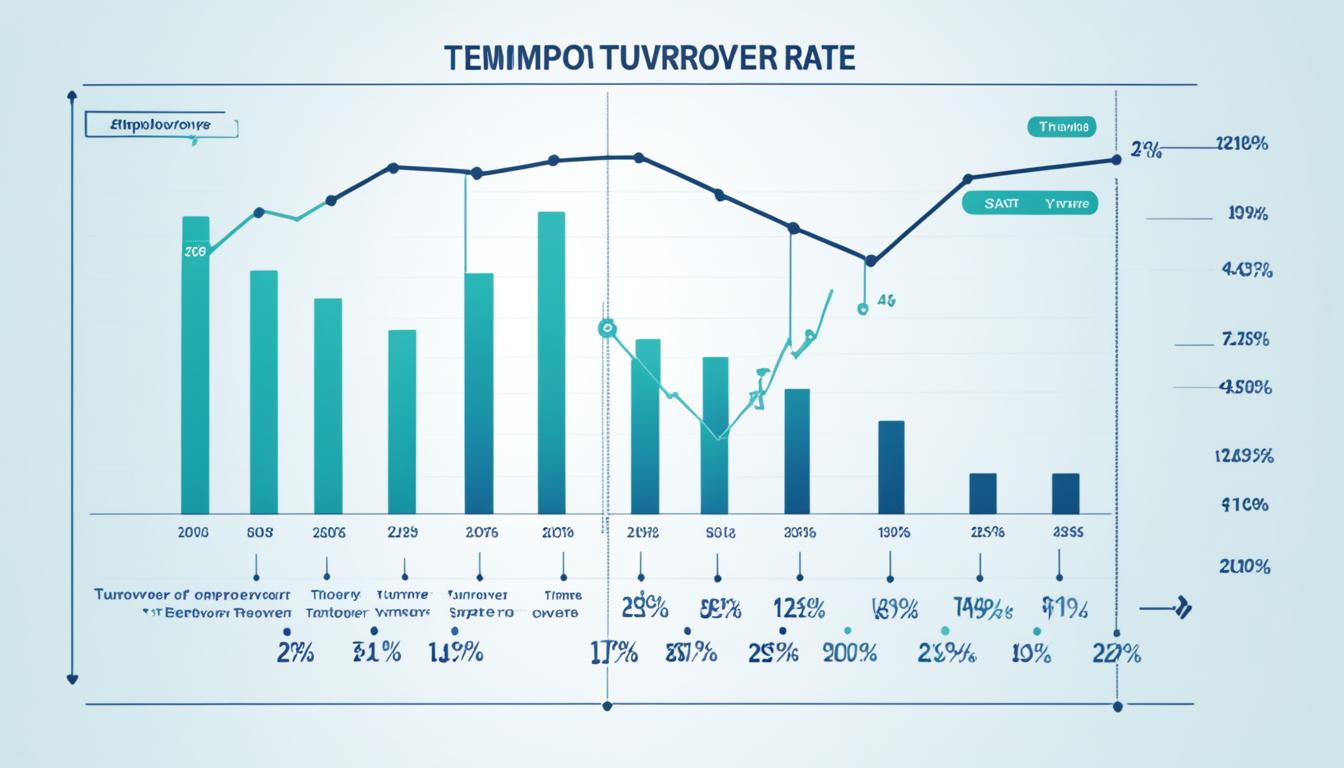Calculating staff turnover is a crucial step in understanding the stability and success of your business. Measuring and analyzing the rate at which employees leave your organization provides valuable insights into employee retention and helps identify areas for improvement. By determining the staff turnover rate and understanding the factors contributing to it, you can take proactive steps to enhance employee retention and create a more engaged workforce.
In this article, we will explore the importance of calculating and interpreting staff turnover rates. We will also discuss how to use an employee turnover calculator and how to calculate staff turnover manually. Additionally, we will delve into the significance of benchmarking your turnover rate against industry averages and offer actionable strategies for reducing staff turnover.
Why Calculate Staff Turnover?
Measuring staff turnover is essential for evaluating the effectiveness of your human resources management system and overall organizational management. By understanding the reasons and implications behind employee turnover, you can make informed decisions to improve employee retention and overall business performance.
One important aspect of calculating staff turnover is utilizing the employee turnover formula. This formula allows you to determine the turnover ratio by dividing the number of employees who left by the average number of employees during a specified period. By keeping track of this turnover ratio, you can identify trends and patterns, helping you to take proactive measures to address turnover issues.
“Calculating staff turnover is crucial for assessing the stability and success of your business. By understanding the process of calculating staff turnover, you can gauge employee retention and identify areas for improvement.” – HR Metrics Expert
Additionally, HR turnover metrics play a vital role in assessing the effectiveness of your employee retention strategies. By analyzing these metrics, such as voluntary turnover rate and involuntary turnover rate, you can gain valuable insights into the reasons employees are leaving. This information can then be used to address underlying issues and improve retention strategies.
Understanding the HR turnover metrics and employee turnover formula allows you to develop a comprehensive view of your organization’s turnover rate. This information is crucial in identifying potential problems within your company and implementing effective solutions to reduce turnover and increase employee satisfaction and engagement.
Benefits of Calculating Staff Turnover
- Identify areas for improvement in human resources management
- Assess the effectiveness of employee retention strategies
- Identify trends and patterns affecting turnover
- Address underlying issues affecting employee satisfaction and engagement
By carefully calculating staff turnover and analyzing the data, you can take proactive measures to improve employee retention, create a positive work environment, and enhance the overall success of your organization.

How to Use an Employee Turnover Calculator?
An employee turnover calculator is a valuable tool that simplifies the process of calculating staff turnover. By utilizing this calculator, you can efficiently assess the workforce turnover rate in your organization. Here are the steps to effectively use an employee turnover calculator:
Step 1: Gather Data
Start by gathering the necessary data to input into the calculator. You will need:
- The average number of active employees during the specified time period.
- The total number of employees who have left the company within the same time frame.
- The duration of the time period for which you want to calculate the turnover rate.

Step 2: Input Data
Once you have the required data, input it into the employee turnover calculator. The calculator will typically have fields to enter the average number of active employees, the number of employees who have left, and the duration of the specified time period.
Step 3: Calculate Turnover Rate
After inputting the data, the employee turnover calculator will automatically calculate the turnover rate as a percentage. This percentage indicates the level of staff turnover in your organization during the specified period. The higher the percentage, the higher the workforce turnover rate.
“An employee turnover calculator streamlines the process of determining the workforce turnover rate and offers valuable insights into the stability of your organization.”
Using an employee turnover calculator saves time and effort, providing you with accurate turnover analysis techniques. It helps identify trends and patterns in employee churn, allowing you to make informed decisions to improve employee retention and reduce turnover.
How to Calculate Staff Turnover Manually?
If you prefer to calculate the staff turnover rate manually, you can use the following turnover analysis method:
Formula: (Total number of leavers ÷ Average number of active employees) x 100
This method requires knowing the number of employees who have left and the average number of active employees over the same period. By plugging these values into the formula, you can obtain the turnover rate calculation as a percentage.
Example Calculation:
Let’s say in a given year, your company had 50 employees leave and an average of 200 active employees:
(50 ÷ 200) x 100 = 25% turnover rate
This example demonstrates how the staff attrition formula can be used to calculate the turnover rate for your organization.
| Number of Leavers | Average Number of Active Employees | Turnover Rate |
|---|---|---|
| 50 | 200 | 25% |
By regularly monitoring and calculating the turnover rate using this method, you can track changes over time and gain valuable insights into employee retention within your organization.
Interpreting Staff Turnover Rates
Interpreting staff turnover rates is vital for gaining insights into your organization’s performance. By comparing your turnover rate with industry averages, you can assess whether your rate is high or low. A high turnover rate may indicate management or organizational issues, while a low turnover rate suggests better employee retention.
When analyzing staff turnover, it is essential to consider employee retention metrics and conduct workforce turnover analysis. This involves calculating staff churn by examining the reasons for turnover. For instance, low job satisfaction and limited growth opportunities are common factors contributing to employee attrition.
Employee retention metrics play a significant role in determining the effectiveness of your retention strategies. By tracking and analyzing data such as turnover rates, you can identify areas of improvement and implement measures to enhance employee satisfaction and reduce staff churn. Workforce turnover analysis helps uncover patterns and trends, enabling you to make data-driven decisions and take proactive action to address turnover.
“Calculating staff churn is a key task in HR management. By understanding why employees leave and analyzing workforce turnover rates, organizations can implement targeted initiatives to improve employee retention and create a positive work environment.”
In order to effectively interpret staff turnover rates, regular monitoring and assessment of employee retention metrics are necessary. This can be done through workforce turnover analysis, which allows you to identify trends and patterns in staff churn. By conducting a thorough analysis, you can gain valuable insights into the underlying causes of turnover and take appropriate action to improve employee retention.
Remember, reducing turnover and improving retention strategies are ongoing processes. By continually monitoring employee retention metrics and taking proactive steps to address staff churn, you can create a work environment that fosters loyalty, productivity, and long-term success.
Employee Retention Metrics
| Retention Metric | Definition |
|---|---|
| Turnover Rate | The percentage of employees who leave within a specified time period |
| Retention Rate | The percentage of employees who stay with the company over a specific period |
| Voluntary Turnover | The percentage of employees who leave by their own choice |
| Involuntary Turnover | The percentage of employees who are terminated by the company |

Benchmarking and Industry Comparison
When it comes to evaluating your organization’s staff turnover rate, benchmarking it against industry averages can provide valuable insight into your performance. By comparing your turnover rate to the average rate within your industry, you can gain a clear understanding of how competitive your retention strategies are. This analysis helps you identify areas for improvement and take proactive measures to address turnover issues.
Conducting internal turnover rate research allows you to track trends over time and identify any significant changes in your organization. By monitoring your turnover data regularly, you can spot any potential issues and implement strategies to improve staff retention. This proactive approach enables you to address turnover concerns before they escalate.
One effective way to benchmark your staff turnover rate is by calculating the staff retention ratio. This formula is an important measure for understanding your organization’s ability to retain employees. The staff retention ratio can be calculated using the following formula:
Staff Retention Ratio = (Number of Employees at the Start of the Period – Number of Employees who Left during the Period) / Number of Employees at the Start of the Period * 100
Using this formula, you can calculate the ratio as a percentage, which indicates the percentage of employees who remained in your organization over a specified period.
Example Benchmarking Table
| Company | Industry | Average Staff Turnover Rate |
|---|---|---|
| Company A | Finance | 12% |
| Company B | Technology | 8% |
| Company C | Retail | 15% |
The table above illustrates an example of benchmarking staff turnover rates across different companies in various industries. By comparing your turnover rate to industry averages, you can gain a better understanding of where your organization stands and identify areas for improvement.
Remember, benchmarking is an ongoing process that should be conducted periodically. This allows you to stay up-to-date with industry trends and continuously improve your retention strategies.
Taking Action to Reduce Staff Turnover
High staff turnover can have a significant impact on the financial stability and culture of your business. A high turnover rate not only disrupts productivity and increases recruitment costs but also affects employee morale and engagement. To address this issue and foster a more stable and engaged workforce, it is essential to take proactive steps to reduce employee turnover and improve retention strategies.
Importance of Reducing Employee Turnover
“Reducing employee turnover should be a priority for every organization. By improving retention strategies, businesses can retain skilled and experienced employees, maintain a positive work environment, and enhance overall productivity and profitability.” – HR Experts UK
Reducing employee turnover offers several benefits to your organization. Firstly, it helps ensure continuity and stability within your workforce, reducing the costs and disruptions associated with frequent recruitment and training. By retaining valuable employees, you can build a team of experienced professionals who are familiar with your business processes and able to deliver consistent results.
Moreover, reducing turnover positively impacts company culture. When employees witness their colleagues leaving frequently, it can create an atmosphere of uncertainty and insecurity. However, by implementing effective retention strategies, you can create a supportive and nurturing work environment that fosters loyalty, job satisfaction, and long-term commitment among your employees.
Improving Retention Strategies
To reduce staff turnover, it is crucial to implement retention strategies that address the underlying causes of employee attrition. Here are some effective strategies to consider:
- Improve working conditions: Create a positive work environment by addressing issues such as work-life balance, workload management, and fostering strong interpersonal relationships among team members.
- Offer better benefits: Evaluate your employee benefits package and consider enhancements such as competitive salaries, comprehensive healthcare coverage, retirement plans, and opportunities for professional development.
- Provide opportunities for career growth: Implement clear career progression paths, offer training programs, and encourage employees to upskill and advance within the organization.
- Conduct exit interviews and surveys: Gain valuable insights into the reasons behind employee departures through exit interviews and surveys. This feedback will enable you to identify areas for improvement and tailor retention strategies accordingly.
By implementing these strategies, you can create a culture of employee engagement, loyalty, and satisfaction, leading to reduced turnover and improved long-term retention rates. Remember, a proactive approach to addressing turnover is essential for maintaining a motivated and productive workforce.
Reducing employee turnover and improving retention strategies is not a one-time effort but an ongoing process. Continuously evaluate your retention initiatives, monitor staff turnover rates, and adapt your strategies based on emerging trends and employee feedback. By prioritizing employee satisfaction and engagement, you can build a loyal and committed workforce that drives success and growth for your business.
Conclusion
Calculating staff turnover is a vital aspect of assessing and improving employee retention in your business. Understanding how to calculate staff turnover and interpreting the data can empower you to make informed decisions that reduce turnover rates and create a more stable and engaged workforce.
Regularly monitoring your turnover rates and analyzing the reasons behind turnover is key. By identifying any underlying issues, you can take appropriate actions to address them and mitigate the impact of staff turnover. This can involve improving working conditions, offering better benefits, or providing opportunities for career growth.
Remember, creating a positive work environment is essential for retaining valuable employees. By taking proactive steps to reduce staff turnover, you can foster a culture of loyalty and commitment, ultimately benefiting your organization’s long-term success and bottom line.
FAQ
How do I calculate staff turnover?
To calculate staff turnover, you can use the equation: (Total number of leavers ÷ Average number of active employees) x 100. This formula requires knowing the number of employees who have left and the average number of active employees over the same period. By plugging these values into the equation, you can obtain the turnover rate percentage.
Why is it important to calculate staff turnover?
Measuring staff turnover is crucial for assessing the stability and success of your business. By understanding the process of calculating staff turnover, you can gauge employee retention and identify areas for improvement.
How do I interpret staff turnover rates?
Interpreting staff turnover rates is essential for gaining insights into your organization’s performance. Comparing your turnover rate with industry averages can help identify if your rate is high or low. A high turnover rate may indicate management or organizational issues, whereas a low turnover rate suggests better employee retention.
How can I benchmark my staff turnover rate?
Benchmarking your staff turnover rate against industry averages is a valuable practice in understanding your organization’s performance. You can compare your turnover rate to the average rate within your industry to provide insights into how competitive your retention strategies are.
How can I take action to reduce staff turnover?
To address turnover issues, you can take action based on your analysis of the turnover data. This can involve improving working conditions, offering better benefits, or providing opportunities for career growth. Additionally, conducting exit interviews and surveys can help identify and address underlying causes of turnover.
What is the importance of reducing staff turnover?
High staff turnover can have significant financial and cultural impacts on your business. By taking proactive steps to reduce staff turnover, such as improving retention strategies and addressing underlying causes, you can enhance employee retention and create a positive work environment.




